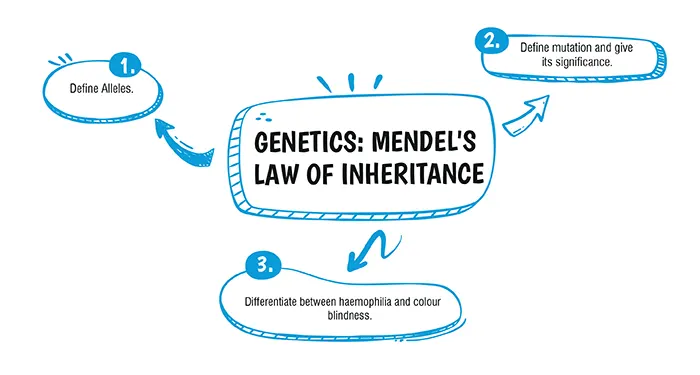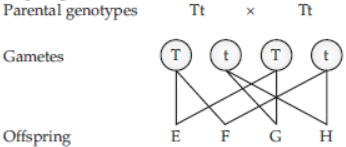Table of Contents

Ans. (c) Both heredity and variation

Ans. (d) The ratio of different phenotypes in the offspring is 1 : 1.
Explanation:
The cross between heterozygous tall (Tt) pea plants will show a phenotypic ratio of 3 (TT,Tt) : 1 (tt).
Explanation:
Alleles: Alleles are the alternative forms of the same gene. For example, tallness and dwarfness are the two alternative forms of a gene for height and are called alleles. Similarly, attached earlobes and free earlobes are alleles for the type of ear lobes.
Explanation:
Any change in genetic composition of an individual brought about by internal or external factors is called mutation. Mutations play a significant role in the evolution and speciation because they cause variation. However, some harmful mutations cause diseases.
Explanation:
| Haemophilia | Colour blindness |
|---|---|
| Haemophilia is a X-linked inheritance disorder. It is a recessive character genetic disease in which individuals suffering from disease lack a factor responsible for clotting of blood. | It is an inherited disorder. The gene of red, green colour blindness is located on the X-chromosome. When this gene is affected, the person is unable to differentiate between the red and green colour. |
Download Mind Map of this chapter
Download NowWant to Practice Mock Tests of this chapter
Practice NowDownload Important Questions of this chapter
Download Now| Chapter No. | Chapter Name |
|---|---|
| Chapter 1 | Structure of Chromosome, Cell Cycle and Cell division |
| Chapter 2 | Genetics: Mendel's law of Inheritance |
| Chapter 3 | Absorption by Roots- The Processes Involved |
| Chapter 4 | Transpiration |
| Chapter 5 | Photosynthesis |
| Chapter 6 | Chemical Coordination in Plants |
| Chapter 7 | The Circulatory System |
| Chapter 8 | The Excretory System |
| Chapter 9 | The Nervous System and Sense Organs |
| Chapter 10 | The Endocrine System |
| Chapter 11 | The Reproductive System |
| Chapter 12 | Human Population |
| Chapter 13 | Human Evolution |
| Chapter 14 | Pollution |
CBSE Important Questions Class 10
ICSE Important Questions Class 10
CBSE Important Questions Class 10
ICSE Important Questions Class 10